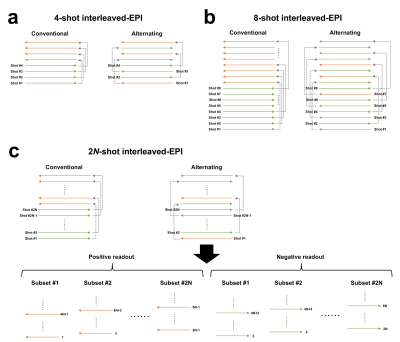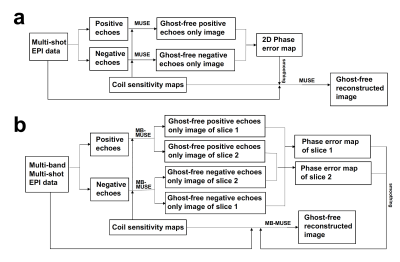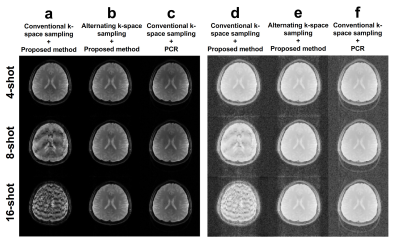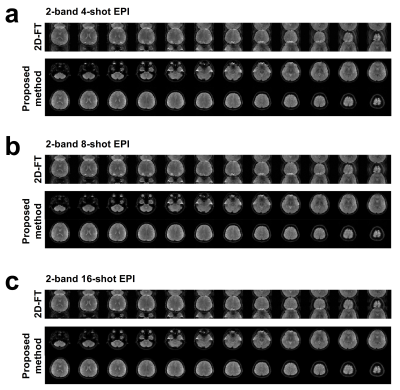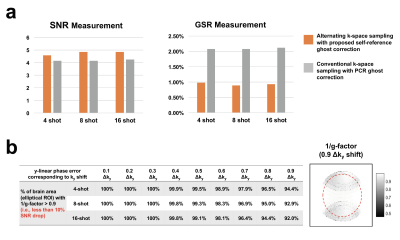4121
Nyquist Artifact Correction for Multi-band and Multi-shot EPI Using Multiplexed Sensitivity Encoding (MUSE) - A Self-reference 2D Phase Correction Method1Department of Diagnostic Radiology, The University of Hong Kong, Hong Kong, Hong Kong, 2The State Key Laboratory of Brain and Cognitive Sciences, The University of Hong Kong, Hong Kong, Hong Kong, 3Philips Healthcare, Hong Kong, Hong Kong, 4Department of Biomedical Engineering, University of Arizona, Tucson, AZ, United States, 5Brain Imaging and Analysis Center, Duke University Medical Center, Durham, NC, United States
Synopsis
Echo planar imaging (EPI) suffers from Nyquist artifact that is typically corrected by using 1D phase correction with reference scan. In oblique-plane acquisition, 2D phase corrected is warranted to effectively reduce Nyquist artifact. However, Nyquist artifact correction is challenging in the case of multi-band EPI due to the presence of slice-dependent phase error. In this study, we aim to develop a self-reference 2D phase correction method to eliminate the Nyquist artifact in multi-band multi-shot EPI data, which utilizes the recently developed multiplexed sensitivity encoding (MUSE) reconstruction algorithm.
Purpose
Nyquist ghost is one of the major artifacts in echo planar imaging (EPI) due to data inconsistences between positive and negative readouts1. Usually, 1D phase correction is applied to reduce Nyquist artifact, and the correction parameters are derived from a reference scan2. In oblique-plane acquisition, 2D phase correction is warranted to effectively reduce Nyquist artifact using either reference-based method3,4 or reference-free phase-cycled reconstruction (PCR)5. The former requires extra scan time, and the latter is time-consuming when mapping 2D non-linear phase error. Moreover, Nyquist artifact reduction for multi-band EPI is challenging due to the presence of slice-dependent phase error6. In this study, we aim to develop a self-reference 2D phase correction method that can eliminate the Nyquist artifact in multi-band multi-shot EPI data.Methods
Data sampling: We propose an alternating k-space sampling pattern for multi-shot EPI acquisition, whereby near uniform distribution of positive and negative samplings across the entire k-space for any number of shots can be achieved. Figures 1a-c show the comparisons between conventional and alternating k-space patterns for interleaved EPI with 4, 8, and 2N in-plane shots. As shown in Figure 1c, the positive and negative k-lines are separated into two data sets, and then rearranged to different subsets of k-space data with same effective acceleration factor (i.e., Reff = 4N).
2D phase correction: All subsets of positive and negative k-space data are respectively used to reconstruct two unaliased images using multiplexed sensitivity encoding (MUSE) algorithm7 with Reff=2. The 2D phase error between positive and negative samplings are subsequently derived from the complex difference between the two unaliased images. Finally, all subsets of data (i.e., from both positive and negative samplings), the estimated 2D phase error and coil sensitivity profile were jointly used in the MUSE algorithm for eliminating Nyquist artifact. Our proposed reconstruction method for the case of single-band multi-shot EPI data is shown in Figure 2a, and that integrated with the multi-band MUSE (MB-MUSE) algorithm8 to simultaneously eliminate through-plane aliasing and Nyquist artifacts in multi-band multi-shot EPI data is shown in Figure 2b.
Experiments: Human brain data were acquired using single-band 4-shot, 8-shot, and 16-shot spin-echo EPI with both conventional and alternating k-space samplings (with matrix=128x128, FOV=240mm) with oblique-plane using 3T Philips MRI scanner with a 32-channel head coil. A set of GRE data was acquired for coil sensitivity estimation. A 2-band multi-shot EPI data set with controlled aliasing was simulated from the single-band data acquired using the alternating k-space sampling pattern. The single-band and simulated 2-band multi-shot EPI data were reconstruct using the flowchart in Figs. 2a & 2b, respectively, to eliminate Nyquist artifacts. For comparison, PCR of the multi-shot EPI data with conventional k-space sampling for Nyquist artifact removal was also performed.
Quantitative evaluation: The signal-to-noise ratio (SNR) and ghost-to-signal ratio (GSR) were measured from all reconstructed images. To assess the performance of our proposed method, we calculated the g-factor penalty associated with the linear phase error along the y-direction.
Results
Figures 3a-c show multi-shot EPI images reconstructed from data acquired with conventional and alternating k-space sampling using our proposed method, as well as data acquired with conventional k-space sampling using PCR. Figures 3d-f show the same images as in Figures 3a-c but with a different display scale. Figure 4 shows different 2-band multi-shot EPI data sets that were reconstructed with direct Fourier transform and our proposed method. Figure 5 shows the quantitative evaluations of our proposed method in terms of SNR, GSR and g-factor penalty.Discussion
We have successfully demonstrated that our proposed self-reference method with alternating k-space sampling pattern and MUSE algorithm can effectively reduce the Nyquist artifact in multi-shot EPI with even number of shots. The proposed method is particularly useful for correcting 2D phase error due to oblique plane acquisition, and mapping slice-dependent phase error. The preliminary test on 2-band multi-shot EPI data demonstrates the feasibility to simultaneously eliminate Nyquist artifacts and through-plane aliasing without the need of reference scan, whilst the reference-free PCR method cannot be directly applied to eliminate Nyquist artifacts. From the result of quantitative comparison, the reconstruction performance of our proposed method is comparable with PCR in terms of SNR and ghost reduction. One minor drawback of our proposed method is an insignificant SNR loss (i.e., less than 10% loss) due to the presence of the linear phase error along the y-direction. In conclusion, our proposed self-reference method with 2D phase correction is a robust reconstruction algorithm for the removal of Nyquist artifacts in multi-band multi-shot EPI data.Acknowledgements
This research is supported by grants from Hong Kong Research Grant Council (GRF HKU17121517).References
[1] Buonocore MH, Zhu DC. (1999) High spatial resolution EPI using an odd number of interleaves. Magn Reson Med. Vol.41(6), p.1199.
[2] Bruder H, Fischer H, Reinfelder HE, Schmitt F. (1992) Image reconstruction for echo planar imaging with nonequidistant k-space sampling. Magn Reson Med. Vol.23(2),p.311.
[3] Chen NK, Wyrwicz AM. (2004) Removal of EPI Nyquist ghost artifacts with two-dimensional phase correction. Magn Reson Med. Vol.51(6), p.1247.
[4] Hu X., Le T. H. (1996) Artifact reduction in EPI with phase-encoded reference scan. Magn Reson Med. Vol.36(1), p.166.
[5] Chen NK, Avram AV, Song AW. (2011) Two-dimensional phase cycled reconstruction for inherent correction of echo-planar imaging Nyquist artifacts. Magn Reson Med. Vol.66(4), p.1057.
[6] Barth M, Breuer F, Koopmans PJ, Norris DG, Poser BA. (2016) Simultaneous multislice (SMS) imaging techniques. Magn Reson Med . Vol.75(1), p.63.
[7] Chen NK, Guidon A, Chang HC, Song AW. (2013) A robust multi-shot scan strategy for high-resolution diffusion weighted MRI enabled by multiplexed sensitivity-encoding (MUSE) Neuroimage. Vol.72, p.41.
[8] Chang HC, Guhaniyogi S, Chen NK. (2015) Interleaved diffusion-weighted improved by adaptive partial-Fourier and multiband multiplexed sensitivity-encoding reconstruction. Magn Reson Med. Vol.73(5), p.1872.
Figures
